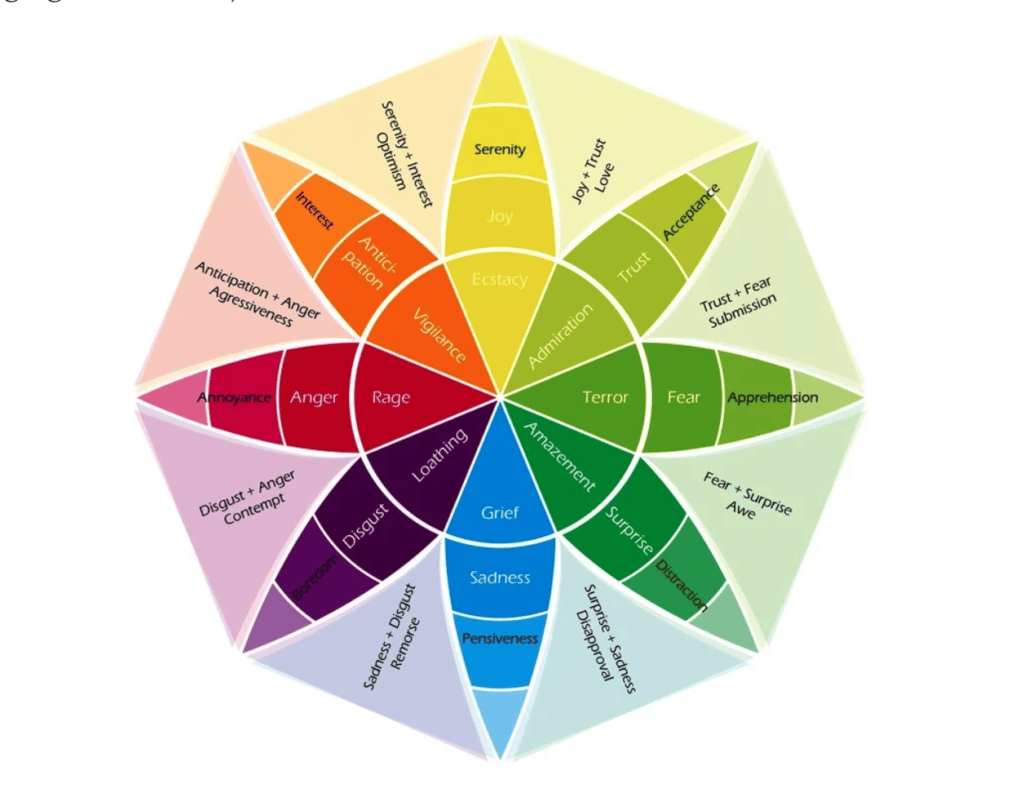Have you ever had a feeling but struggled to find the words to express it? Perhaps you’re enthusiastic about the prospect of something fresh — a new career opportunity for example — but you are also feeling another sensation in addition to the joy: something you cannot quite put into words.
Let’s face it, describing emotions is a complex and challenging job that leaves many individuals bewildered and even more confused than by the feelings themselves. But what if we told you there was a simple way to help you express how you are feeling?
This blog explores how to use Plutchik’s Wheel of Emotions, a valuable tool in providing a simple and logical way to make sense of your feelings.
What is the Plutchik Wheel?
The Wheel of Emotions, also known as a feeling wheel, is a visual representation of primary and secondary emotions. It was created by psychologist Robert Plutchik and is based on his theory of emotions. Plutchick believed that humans can experience over 34,000 unique emotions but, ordinarily, they experience eight primary emotions.

(Image Source: ResearchGate)
These primary emotions include anger, fear, sadness, joy, disgust, surprise, trust, and anticipation. These emotions are arranged as opposites on the wheel:
- Sadness and Joy
- Anger and Fear
- Disgust and Acceptance
- Anticipation and Surprise
Plutchik’s theory is that people cannot experience opposite emotions simultaneously. However, they can share blends of emotions by combining emotions next to each other on the feelings wheel. For example:
- Joy and Acceptance = Love
- Acceptance and Fear = Submission
- Fear and Surprise = Awe
- Surprise and Sadness = Disappointment
- Sadness and Disgust = Remorse
- Disgust and Anger = Contempt
- Anger and anticipation = aggressiveness
- Joy and love = optimism
Plutchick asserts that contradictory blended emotions such as love and remorse cannot be felt simultaneously.
How to use the Wheel of Emotions to detect your mood?
You’ll need to understand the dimensions to begin. In simple terms, the cone’s vertical dimension represents intensity – emotions intensify as they move from the outside to the center of the wheel. For example, a feeling of boredom can intensify to loathing if left unchecked. This is an important rule about emotions to be aware of: If left unchecked, emotions can intensify.
It is important to note that there is no right or wrong way to use the Wheel of Emotions, but there are tips to help you get started!
- Pick a Single Feeling or Emotion
A great starting point is to select the most accurate primary emotion representing how you are feeling. Use your finger to identify more specific emotions (or degrees) that you connect with on the outer edges of the circle. Emotions placed closer to each other in the emotion wheel are deemed more similar than those farther apart. Any emotion outside of the eight primaries is referred to as a secondary emotion, including the core’s center (rage, floating, grief, etc.).
Begin to think about the situation or event causing you to feel this way. It can also be helpful to ask yourself how intense your feelings are. The Wheel of Emotions can be helpful in moments of intense feelings and when the mind cannot remain objective as it operates from an impulsive fight or flight response.
For example, let’s say you’re feeling sad, that’s where you would start on the wheel. You move your finger away from sad towards the outside of the wheel and reach pensiveness. In this dimension, you ask yourself, “What is causing me to feel this way?”. You start reflecting and realize “I’m feeling sad because I am lonely“. That is when you begin to dig a little deeper and realize that the relationship you ended a few months ago has left a void in your day-to-day life.
Now that you have established how you are feeling and why, you can start to strategize ways to improve your mental health.
- Create a List for Multiple Emotions
Experiencing multiple feelings simultaneously happens, so don’t just focus on one primary emotion. Take your time to work through each primary emotion individually. Create a long list of emotions and determine if your feelings are connected to a single root cause or if several emotions contribute to how you’re feeling.
- Choosing Optimism Over Pessimism
We typically over analyze our feelings when we are feeling down or not at our best. However, you can look for ones that help you appreciate life: joy, gratitude, pride, confidence, or creativity. Reading through the list can often remind you of the full range of emotions, not just the negative ones. Maybe you’re grateful for your friends, or you’re happy because you’ve stuck to eating healthy, or perhaps a stranger bought your morning coffee, and you’re feeling thankful.
How Can the Wheel of Emotions Help Me?
The Wheel of Emotions can also help you understand your reactions to certain situations and events. We refer to this as emotional intelligence, which is a person’s overall ability to deal with their emotions, such as staying calm when you feel angry or reassuring yourself when in doubt. Finally, the Wheel of Emotions can be used as a communication tool and improve a person’s ability to communicate their emotions through words and read them to others, referred to as emotional literacy. It includes empathy, i.e. having sensitivity to the feelings of others.
The Bottom Line
Emotions can get complicated. Sometimes, they might confuse you to the point where ignoring them seems like the best way to avoid getting overwhelmed. But leaving emotions unaddressed can often intensify them.
If an emotional expression is difficult for you, you are not alone. A recent survey indicated that 1/4 of people feel they do not have anyone to confide in, with 32% avoiding therapy because they do not have the time, 26% feeling their problems are not serious enough, and 26% feeling too embarrassed. Because emotions are complex, exploring and discussing your feelings is usually the best approach to improving mental health and overall well-being. If you are struggling to express yourself or manage your emotions, you may want to consider speaking to a licensed therapist.
How Focus Mental Wellness can help
Focus is an online therapy service with licensed therapists who are passionate about making mental health care accessible to all.
Many people now opt for online treatment since this arrangement is more convenient and manageable for busy lifestyles. Online therapy is right at your fingertips rather than needing to amend your schedule to attend an in-person therapy appointment, and you can take the call from the comfort of your own home using any device you want! The best part about Focus is that you choose your own therapist and it’s more affordable than in-person therapy.
If you need assistance in navigating your emotions, remember that Focus is here for you, and you can book an appointment today!



